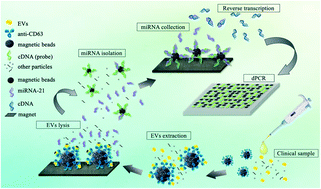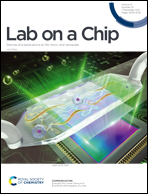Isolation and quantification of extracellular vesicle-encapsulated microRNA on an integrated microfluidic platform†‡
Abstract
Ovarian cancer (OvCa) is the most fatal among gynecological cancers and affects many women worldwide. Since OvCa is prone to metastasis, which significantly increases chances of death, biomarkers for early-stage OvCa are greatly needed. This study develops an integrated microfluidic platform for isolating and quantifying one of the OvCa blood biomarkers. As a demonstration, microRNA-21 (miRNA-21), which is one of the important biomarkers for cancers, was isolated and measured in this study. Extracellular vesicles (EVs) in blood were first captured and isolated by anti-CD63-coated magnetic beads. Then, EV-encapsulated miRNA-21 was isolated by complementary DNA-coated magnetic beads, and finally the isolated miRNA-21 was quantified by digital polymerase chain reaction (digital PCR, dPCR). The integrated chip featured a sample treatment module and a miRNA quantification module that automated the entire process, and the limit of detection (LOD) was 11 copies per mL. The inaccuracy of the miRNA quantification module (i.e. dPCR) was found to be <12%. Additionally, spiked samples and clinical samples were used to test the performance of the developed platform. It is envisioned that the developed system can serve as a valuable and promising tool for OvCa biomarker measurements.

- This article is part of the themed collection: Miniaturised Sensors & Diagnostics


 Please wait while we load your content...
Please wait while we load your content...